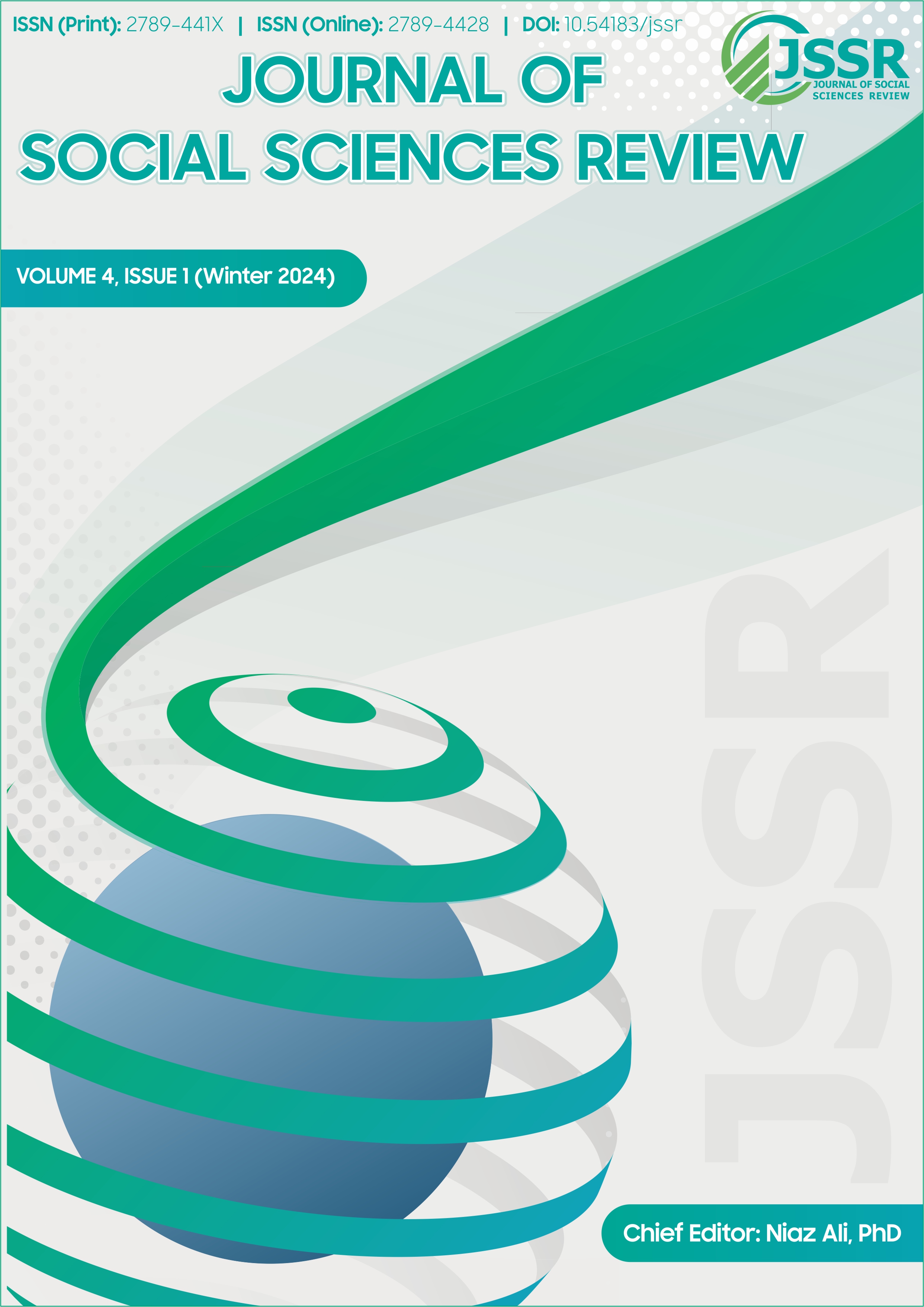Terrorism and Insurgency in the Tribal Areas: Investigating the Historical Roots and Dynamics of Terrorism and Insurgency in Pakistan's Tribal Regions
DOI:
https://doi.org/10.54183/jssr.v4i1.400Keywords:
Militancy, Tribal Areas, Pakistan, Historical RootsAbstract
This research delves deeply into the origins and evolving dynamics of various regions in Pakistan, presenting a nuanced and intricate image shaped by diverse elements and social intricacies. The interplay between global developments and inherent complexities has given rise to a milieu fraught with persistent challenges. These regions, steeped in historical tribal traditions, have experienced pronounced instability, exacerbated by pivotal events such as the Soviet-Afghan War. The study systematically investigates the transformative journey of terrorism and insurgency, scrutinizing the contributing variables. The primary objective of this paper is to furnish readers with a comprehensive understanding of the factors underpinning terrorism and insurgency in Pakistan's tribal areas. It accomplishes this by delving into historical events, cultural components, and geopolitical influences that have intricately woven the tumultuous past of the region.
References
Atran, S. (2003). Genesis of suicide terrorism. Science, 299(5612), 1534–1539. https://doi.org/10.1126/science.1078854
Azar, E. (1988). Terrorism: A global perspective. Terrorism, 11(5), 348-350. https://doi.org/10.1080/10576108808435729
Barakzai, A. (2015). Impact of the Soviet-Afghan War on Pakistan's Tribal Regions. International Journal of Security and Conflict Resolution, 10(3), 210-232.
Barakzai, A. (2015). Legacy of the Soviet-Afghan War: Global Implications on Geopolitical Dynamics. International Journal of Security and Conflict Resolution, 10(4), 345-367.
Basit, A., & Ahmed, Z. S. (2021). The persistence of terrorism in Pakistan: An analysis of domestic and regional factors. In Terrorism, Security and Development in South Asia (pp. 157-174). Routledge.
Daraz U., Naz A. & Khan W. (2012) Sociological analysis of terrorism in Pakistan. Academic Research International, 3(1).
Gul, S., Farooq, S., & Afridi, S. A. (2020). A media framing analysis of political-military narrative on Pakistan's military operation Zarb-E-Azb. Global Mass Communication Review, V(I), 59-74. https://doi.org/10.31703/gmcr.2020(v-i).05
Hussain, F. (2017). Diverse Objectives: Understanding the Mosaic of Insurgency in Pakistan's Tribal Areas. Journal of Insurgency Studies, 18(4), 432-454.
Khan, A. (2022). Understanding the Governance of Federally Administered Tribal Areas of Pakistan: Identity, Culture, Political History, and Governance of Tribal Pakhtuns. In Mainstreaming the Tribal Areas (ex-FATA) of Pakistan Bordering Afghanistan: Challenges and Prospects (pp. 63-110). Singapore: Springer Nature Singapore.
Malik, N. (2019). Comprehensive Counterterrorism Strategies: Beyond Military Measures. Journal of Conflict Studies, 31(1), 78-98.
Malik, N. (2019). Understanding the Complex Web of Terrorism: A Socioeconomic Perspective. Journal of Political Violence, 25(2), 189-211.
Puri, S. (2012). Pakistan's War on Terrorism. https://doi.org/10.4324/9780203154199
Qureshi, R. (2018). State-Tribes Relations in Pakistan: A Historical Perspective. Journal of Political Sociology, 30(4), 345-367.
Rana, M. A. (2011). Evolution of militant groups in Pakistan. Conflict and Peace Studies, 4(2), 107-133.
Rashid, A. (2014). Insurgent Groups in Pakistan's Tribal Belt: A Comparative Analysis. Terrorism Studies Quarterly, 22(3), 301-322.
ur Rahman, H. (2009). Rising Trends of Terrorism: Causes, Dynamics, and Remedies (A case study of Pakistan). Dialogue, 4(3), 410.
Wasim, A. (2020, December 22). Fazl among 20 politicians facing ‘serious threats to life’: minister. DAWN.COM. https://www.dawn.com/news/1597138
Zeman, P. M. (2009). Tribalism and terror. Small Wars & Insurgencies, 20(3-4), 681-709. https://doi.org/10.1080/09592310903043675
Downloads
Published
Issue
Section
License
Copyright (c) 2024 Copyright in the Journal of Social Sciences Review is retained by the author(s). Authors also grant any third party the right to use the article freely as long as its integrity is maintained and its original authors, citation details and publisher are identified.

This work is licensed under a Creative Commons Attribution-NonCommercial 4.0 International License.
SSR's Editorial Board shares the vision of providing free access to information, education, and science for everyone, thus promoting its content through an OPEN ACCESS POLICY, fulfilling the DOAJ definition of open access. The JSSR adheres to an Open Access and Copyright Licensing Policy based on the belief that making research freely accessible to the public promotes greater global knowledge sharing.
The JSSR uses the Creative Commons Attribution-NonCommercial 4.0 International License. The authors who apply and publish in JSSR consent to abide by the copyright policy set out in the Creative Commons 4.0 license (Attribution-NonCommercial 4.0 International license).
- Copyright in the Journal of Social Sciences Review is retained by the author(s).
- Authors also grant any third party the right to use the article freely as long as its integrity is maintained and its original authors, citation details and publisher are identified.
While "By 'open access' to this literature, we mean its free availability on the public internet, permitting any users to read, download, copy, distribute, print, search, or link to the full texts of these articles, crawl them for indexing, pass them as data to software, or use them for any other lawful purpose, without financial, legal, or technical barriers other than those inseparable from gaining access to the internet itself."



